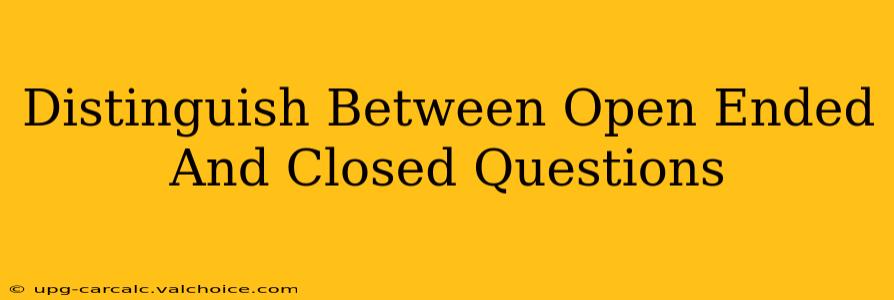Effective communication hinges on asking the right questions. Understanding the difference between open-ended and closed questions is crucial for eliciting the information you need and fostering meaningful conversations. This guide will clearly define each type, highlight their respective strengths and weaknesses, and offer practical examples to illustrate their application.
What are Open-Ended Questions?
Open-ended questions are designed to encourage detailed, thoughtful responses. They don't have a predetermined answer and invite the respondent to share their perspectives, experiences, and feelings. These questions typically begin with words like "what," "why," "how," "tell me about," or "describe."
Key Characteristics of Open-Ended Questions:
- Broad scope: They allow for a wide range of answers.
- Encourages elaboration: Respondents are prompted to explain their thoughts and feelings in detail.
- Reveals deeper understanding: Provides insights into the respondent's perspective and reasoning.
- Facilitates richer conversations: Promotes more in-depth and engaging discussions.
Examples of Open-Ended Questions:
-
Instead of: "Do you like your job?" (Closed)
-
Ask: "Tell me about your experience at your current job." (Open-ended)
-
Instead of: "Are you satisfied with our service?" (Closed)
-
Ask: "What are your thoughts on the service we provided?" (Open-ended)
-
Instead of: "Did you find the instructions clear?" (Closed)
-
Ask: "How clear did you find the instructions, and what could make them better?" (Open-ended)
What are Closed Questions?
Closed questions are those that can be answered with a short, specific response. They typically elicit a "yes" or "no" answer, a single word, or a choice from a limited set of options.
Key Characteristics of Closed Questions:
- Narrow scope: Limits the range of possible answers.
- Quick and efficient: Provides rapid information gathering.
- Easy to analyze: Data collected is easily quantifiable.
- May not reveal nuanced perspectives: Can restrict the respondent's ability to fully express their thoughts.
Examples of Closed Questions:
- "Are you happy with your purchase?"
- "Did you attend the meeting yesterday?"
- "What is your age?" (While requiring more than a "yes/no," it still restricts the answer to a specific piece of information).
- "On a scale of 1-5, how would you rate your satisfaction?"
When to Use Each Type of Question
The best type of question to use depends heavily on your context and objective:
Use open-ended questions when you want to:
- Gather in-depth information.
- Understand perspectives and feelings.
- Encourage detailed explanations.
- Build rapport and trust.
- Explore complex issues.
Use closed questions when you want to:
- Gather specific information quickly.
- Confirm facts.
- Make quick decisions.
- Conduct surveys or polls.
- Analyze data easily.
Combining Open-Ended and Closed Questions
For optimal communication, it’s often beneficial to use a combination of both open-ended and closed questions. You can start with a broad open-ended question to explore a topic and then follow up with more specific closed questions to clarify certain points or gather quantifiable data. This approach offers a balanced strategy that maximizes your understanding.
By mastering the art of asking both open-ended and closed questions, you'll significantly improve your communication skills and gather the information you need effectively. Remember to choose the question type that best suits your specific needs and the context of the conversation.

